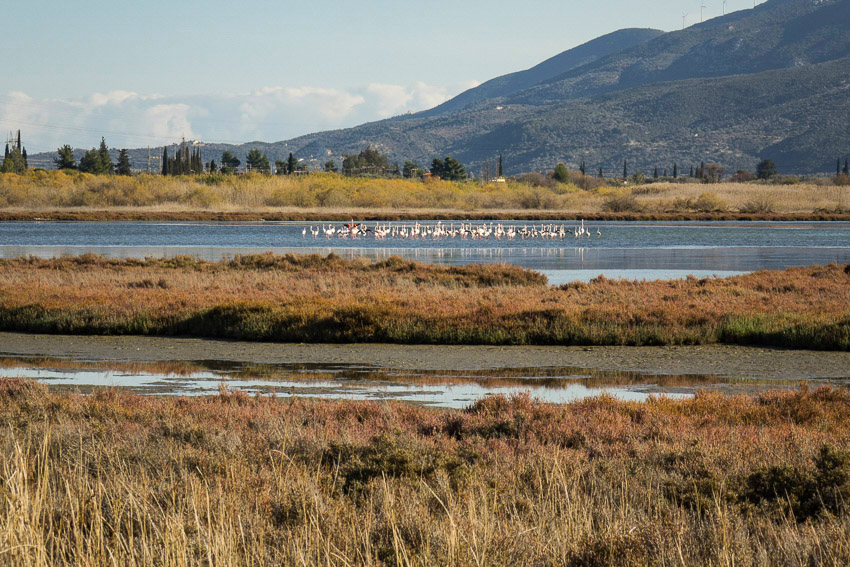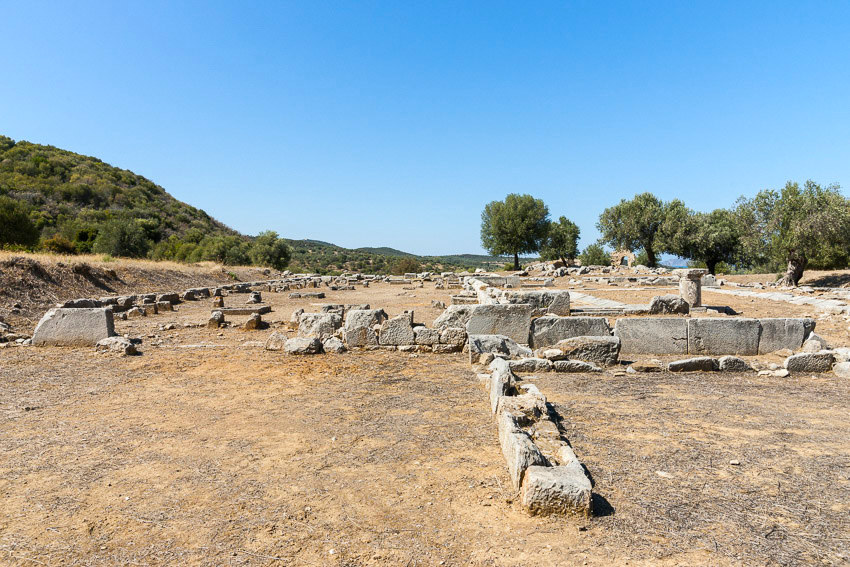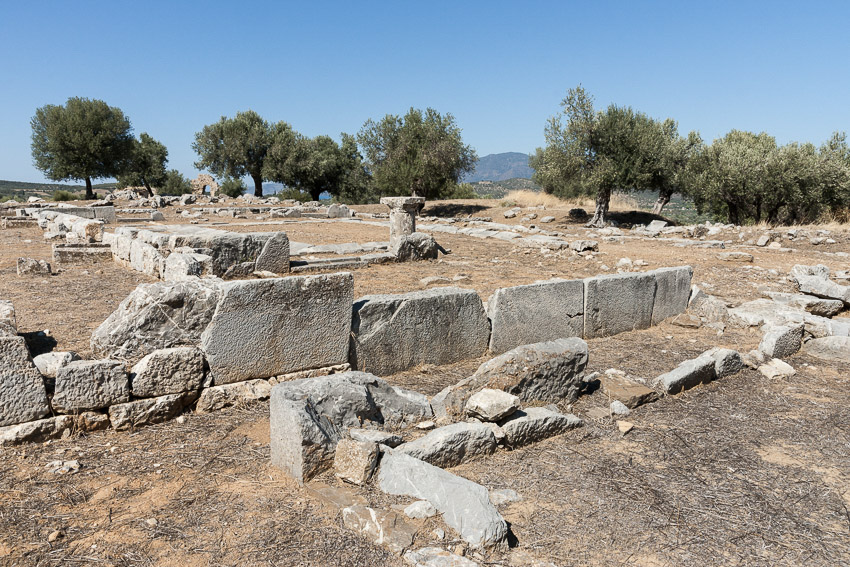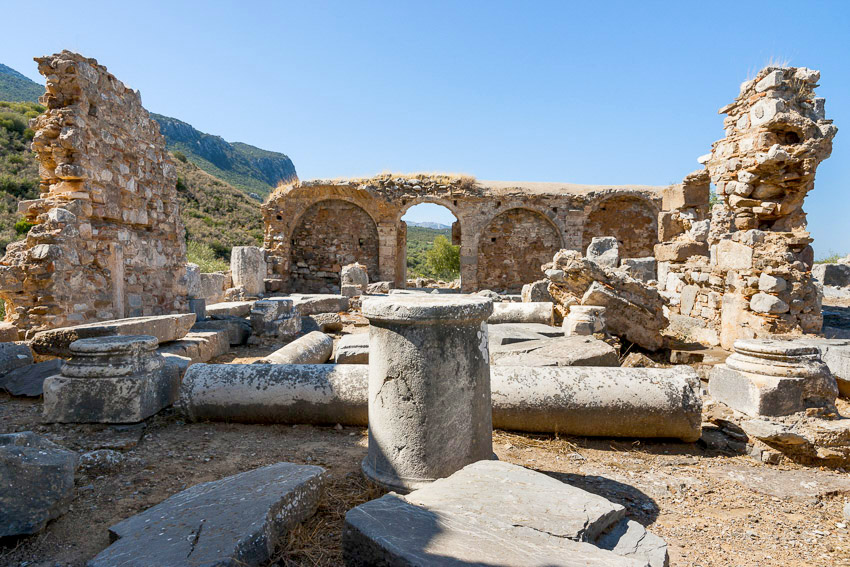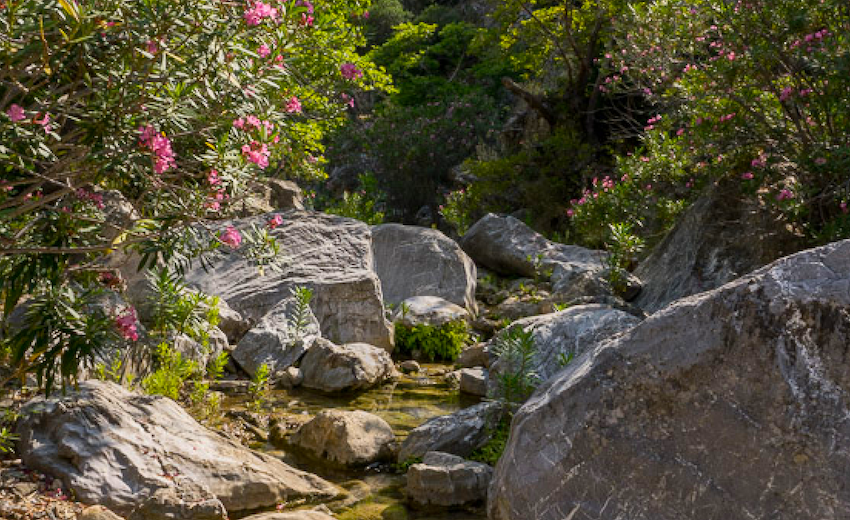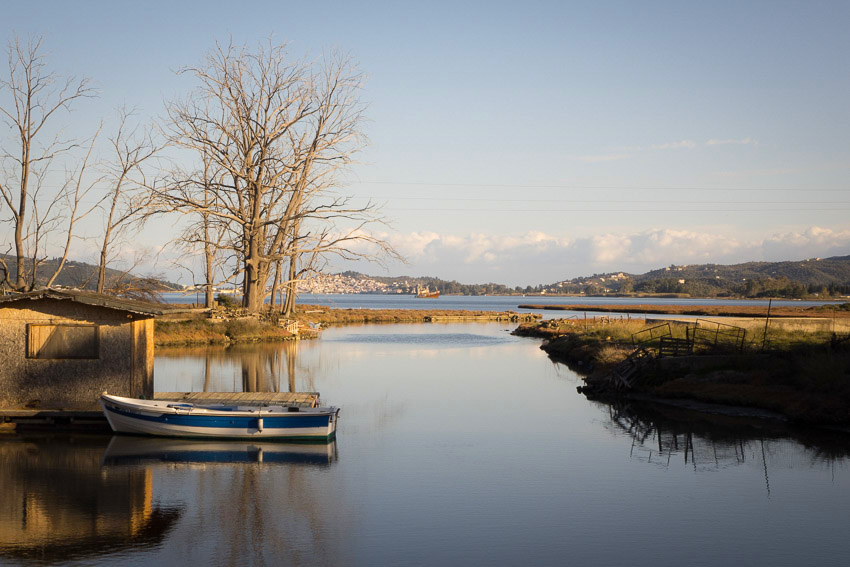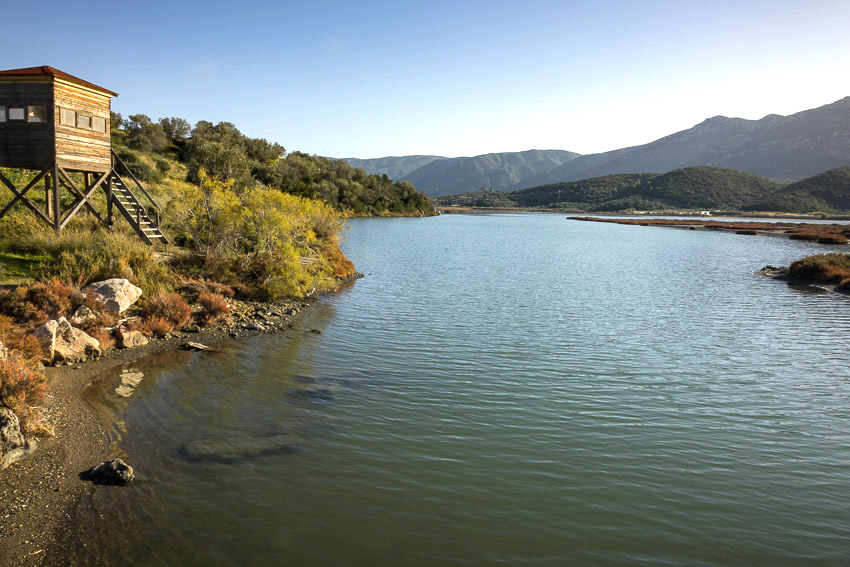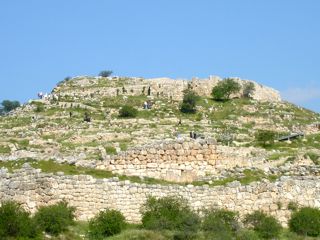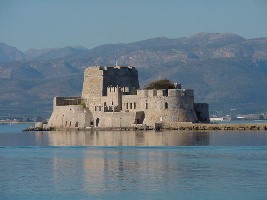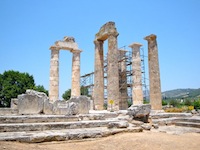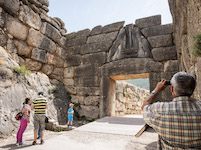
Troezen (Troizina)
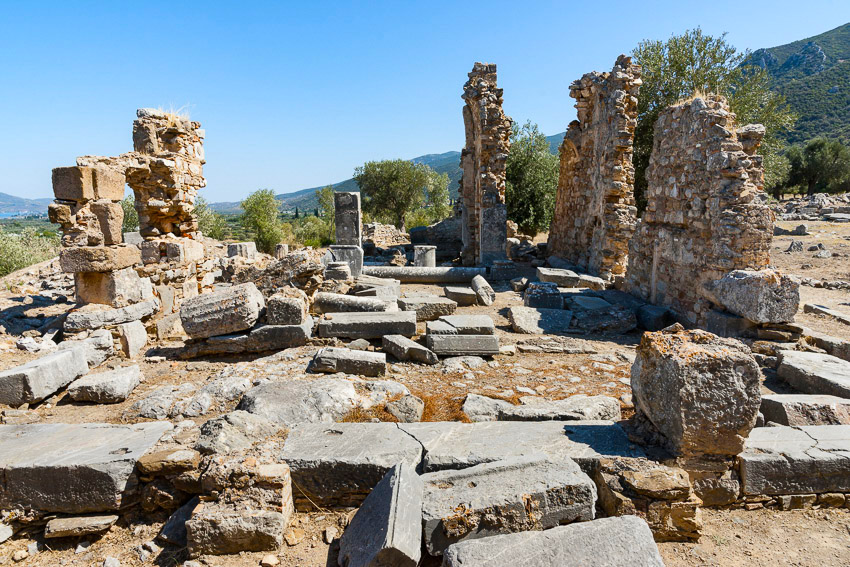
The Church of the Panagia Episkopi on top of the Temple to Aphroditi
Troezen: Where Pegasos struck his hoof on the earth |
|||
|
Of the many cities in Ancient Greece famous for their heroes, myths, and legends, Troezen is probably the one that is least known to the general public. This is mostly due to the fact that this city has seen just a few, very fragmentary, archaeological excavations as the ancient walls and temples of its akropolis on top of a very high hill with very steep slopes almost completely disappeared under a Frankish citadel in the 13th century CE and the monuments, houses, streets, and agora at the foot of the hill have now been covered by countless citrus trees and agricultural installations. At the end of the 19th century CE French archaeologist Philippe Legrand was the first to search for the many temples, monuments, and statues that once adorned the city. In the 1930s German archaeologist Gabriel Welter carried out a more detailed study of the Sanctuary of Hippolytos, the Asklepieion, and the Temple of Aphrodite which are located just outside the city walls, to the North-West. A few years ago, Greek archaeologist Maria Giannopoulou excavated a number of tombs in the eastern cemetery at the edge of the city, some of which contained bronze vessels, figurines, and mirrors. Quite recently (2012 - 2016) new archaeological investigations were carried out with the aim of producing a complete and detailed map of the city, its temples, and its akropolis, in preparation of future excavations. For the untrained eye, however, the glory of Ancient Troezen has all but disappeared and its modern namesake only consists of a few streets with a few houses and churches, and a few inhabitants trying to make their living out of growing oranges, lemons, and other delicious fruits and vegetables. Their wealthy ancestors of several millennia ago founded the cities of Sybaris in Magna Graecia (Sibari in present-day Italy) and of Halikarnassos in Asia Minor (Bodrum in present-day Turkey), where the monumental tomb of king Mausolos (hence the word "mausoleum") became one of the Seven Wonders of the Ancient World. And perhaps even more significant are Troezen's link with Athens, in myth and in history, and its fame for being the place where a handsome young man called Hippolytos lived, raced his horses and chariot, but died a tragical death, and was therefore worshipped as a hero. The origins of the city are not easy to trace, but the topography of the site which allowed it to have a large, sheltered harbour, plenty of fresh water, and fertile soil to grow all kinds of crops, must have made it a very desirable area to live in since prehistoric times. The myths surrounding the birth of the city speak of an Egyptian nobleman or king called Oros founding the city and naming it Oraia. Leis, the daughter of Oros, became pregnant by Poseidon and gave birth to a son, called Althepos, who succeeded his grandfather on the throne and re-named the city and its region Althepia. |
|||
|
|
|||
|
The goddess Athena and the god Poseidon both disputed the patronage of this land but were told by Zeus to hold it in common. This is why the citizens of Troezen later on showed both Poseidon's trident and Athena's portrait on their coins. Today, a visit to Troezen and the area of its old harbours still easily explains this part of its mythological past, as the presence of both Poseidon as god of the sea and Athena as goddess of the land, agriculture, and olive trees, and their dispute can be seen all around the area which lies to the north of the city, especially in the marshy lagoon of Psifta to the NW and in the very shallow bay and harbours of Vidi and Agios Georgios to the NE. Over many thousands of years both Land and Sea in that area have risen, have fallen, and have sometimes even changed shape because of the activities of the neighbouring volcano of Methana, which is now connected to the mainland but was once separated from it by a narrow strait. That particular area and one of the villages close to it is called Metamorphosi for a very good reason. Althepos' successor on the throne of Althepia (Troezen) was king Saron, after whom the Saronic Gulf was named when he drowned in its waters chasing a prey. The doe which he was pursuing, dashed into the sea and swam further and further from the shore until Saron drowned in the waves. After the death of Saron a number of kings ruled the area until two brothers founded two different cities in the region that later on would become the land of Troezen: Hyperes ruled in Hyperea, his brother Anthas in Anthea. Things become even more complicated when Aetios, son of Anthas, succeeds his father and uncle, and renames one of the cities Poseidonias. Aetios is joined by two brothers who had their roots in the region of Elis, in the West of the Peloponnesos. Their names are Troezen and Pittheus. They seem to rule the area together until after the death of Troezen, when Pittheus becomes the sole ruler of the area, joins the cities of Hyperea and Anthea into one city, and calls it Troezen in honour of his deceased brother. This is the time when the mythological (hi)stories of Troezen and Athens as well as the lives of their legendary founders become intertwined. When Pittheus reigned in Troezen, Aegeas was king in Athens. Aegeas married twice but both marriages remained childless - reason enough to consult the Pythia, the oracle in the Sanctuary of Apollon in Delphoi. The answer of the priestess was enigmatic, but only for those who had trouble understanding a certain kind of metaphor in a certain kind of context: "The bulging mouth of the wineskin, loosen it not until you reach Athens." Apparently, Aegeas was one of those who didn't understand... |
|||
|
|
|||
|
As Pittheus in Troezen had the name and fame of being wise, Aegeas decided to make a detour upon his return to Athens and ask for enlightenment about the wineskin. Although Pittheus understood the oracle immediately, he didn't explain anything to Aegeas. Instead he gave him plenty of food and plenty of wine, and on top of that his daughter Aithra to keep him company during the night. When Aegeas was "spent" and fast asleep, the goddess Athena appeared to Aithra as in a dream and instructed her to get up and wade across the shallow waters to the island of Sphairia (current-day Poros) to pour a libation in the sanctuary of Sphairos (the legendary charioteer of king Pelops). But upon her return, wading across the sea, she was impregnated by Poseidon. Aithra only told her father about this, but when it became obvious that she was pregnant, the father of the child would never really be known to her for sure. Aithra gave birth to a son: Theseus. When Aegeas finally decided to return to Athens, he covered his sword, shield, and sandals under a huge rock that served as an altar to Zeus. He told Aithra that when their son would grow up and be strong enough to move the rock and find his weapons, he should bring them to him in Athens. Young Theseus moved the rock, did as his father Aegeas had asked his mother, and grew up to be king of Athens and Troezen, and one of the most famous heroes in history. Killing the Minotaur in the labyrinth of Knossos was just one of his heroic adventures. |
|||
|
One mythical story playing in Troezen simply gives birth to the next one, as so often is the case in Greek mythology. Theseus and the Amazon queen Hippolyta (according to other sources her name was Antiope) had a son called Hippolytos. When Theseus married his second wife Phaedra, she irresistibly fell in love with her stepson Hippolytos, who was a great charioteer. Hippolytos, however, rejected her advances. Spurned, Phaedra committed suicide but left a deceiving note to Theseus, falsely claiming that Hippolytos had tried to rape her. Theseus furiously cursed his son and called upon Poseidon to punish him. Hippolytos takes his chariot to flee the wrath of his father but his horses become terrorised by the sudden appearance of a sea-monster, his chariot crashes, and he is dragged to a painful death. Although this version of the story, as presented in Euripides' play of the 5th century BCE, ends tragically, another version tells us how Asklepios, the god of medicine who had his sanctuary in nearby Epidauros, managed to save Hippolytos' life and bring him back from the dead, on request of the goddess Artemis whom Hippolytos had worshipped all his life. This is why, in the only archaeological site of Troezen that is currently worthy of that name, the sanctuary of Hippolytos and the local Asklepieion (the sanctuary of Asklepios with its medical centre) were built next to each other. Legend has it that all Troezen girls traditionally dedicated a lock of their hair to Hippolytos in his temple just before their marriage. |
|||
|
|
|||
|
What is not a legend but a historical fact linking once again the city states of Athens and Troezen, is what happened during the 2nd Persian invasion of Hellas (Greece) in August or September 480 BCE. Whilst at the Thermopylai the Spartan king and general Leonidas with 300 Spartans, 700 Thespians, and 400 Thebans, held off more than 100,000 Persians for several days, the Athenian statesman and general Themistokles commanded an allied navy of 271 triremes against the Persian fleet of 1,200 ships at the naval battle at Artemision. Although the Persians won both battles, they had lost a lot of ships, soldiers, and time. That time was used by Themistokles to re-assemble his triremes at the island of Salamis, to the West of Athens, and to give the order to evacuate all women, children, and older people from Athens to Troezen, on the other side of the Saronic Gulf. The Persian army of king Xerxes invaded Boeotia and Attika, devastating Thebes, Athens, and the Akropolis, but the Athenian population had escaped safe and well to Troezen, and a few weeks later Themistokles' triremes managed to defeat the Persian navy at the battle of Salamis. Xerxes retreated with much of his army back to Persia and its remaining forces were beaten decisively at the battles of Plataia and Mykale a few months later. The citizens and artists of Athens, having returned safely from Troezen, re-built the Akropolis. |
|||
|
|
|||
|
In the centre of the modern town of Troizina a tourist map gives information on where all the archaeological remains and monuments that can be visited, are located. The site of the sanctuaries of Hippolytos and Asklepios is situated near the small church of Saint Christopher (Agios Christophoros), a few hundred meters outside the city walls of Ancient Troezen, to the NW. Although the site is small, a visit is worthwhile because of the many interesting features still visible around the ruins, such as a number of wells and what has been interpreted by some as the site of the tomb of Phaedra. And what now is the ruined church dedicated to Panagia Episkopi and featuring a lot of ancient architectural elements, was in fact the Temple of Aphrodite in Antiquity - the place from where Phaedra stealthily watched Hippolytos exercise in the stadium next to the temple precinct. Although the stadium has been located with a high degree of certainty, it was never excavated. |
|||
|
|
|||
|
In Greece basically all churches and monasteries were built on top of the remains of Ancient Greek temples or shrines to christianise the sites and the area around them. This could explain why the famous Temple of Artemis in Troezen hasn't really been found yet, but could well be hidden underneath the church of Agios Georgios or the one dedicated to Agios Ioannis in the middle of the citrus trees next to the deep, dried up riverbed of the Chrysorroas. The city of Troezen used to be protected by the Chrysorroas to the West and by the river which is now called Agios Athanasios to the East, as both formed natural defences to which brick walls seemed to have been added in Hellenistic or Roman times. Both rivers find their sources in the Aderes mountains to the South of Troezen and run through beautiful canyons with lots of wildlife (including frogs, lizards, dragonflies, and snakes!), very old Platanus trees, huge marble boulders, and small cascades and ponds). The akropolis of Troezen with its many temples was located high upon a steep hill in between these two canyons, but most of its architecture disappeared when the blocks and columns were re-used to build a Frankish citadel on the same spot in the 13th century CE. |
|||
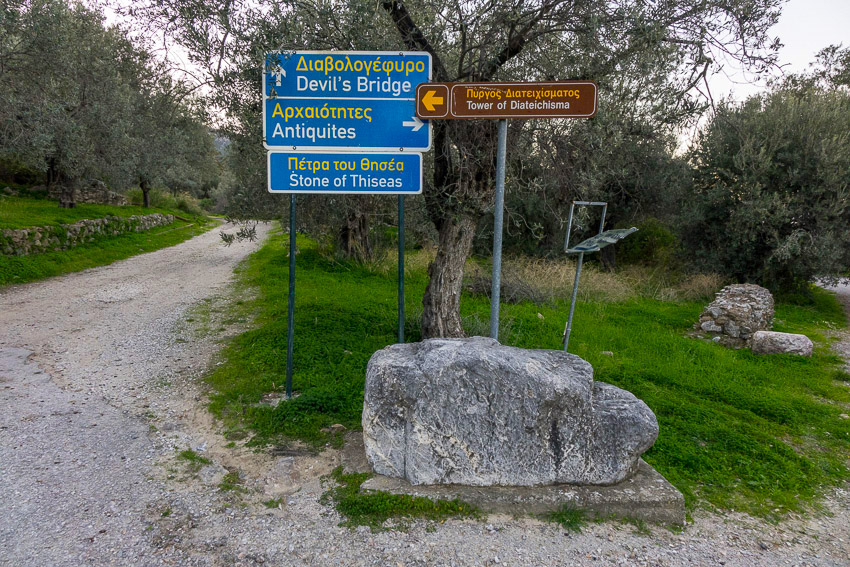 |
|||
|
At the crossing of the roads leading to the foot of the hill of the akropolis and to the church of Agios Ioannis lies the so-called "Stone of Theseus". If this really is the stone under which Aegeas put his sword, shield, and sandals for his son Theseus, is anyone's guess. In these cases the Italians usually say "Se non è vero, è ben trovato!" (If it is not true, it is a good story!)... Another "good story" can be seen a little further uphill on the road towards the "Devil's Bridge": one of the three square towers of the "diateichisma", which was a defensive wall running from the Chrysorroas to the Agios Athanasios river east of the city of Troezen, has been very well preserved and used to be called rather romantically the "Palace of Theseus". Archaeology has identified the lower parts as dating to Hellenistic times (3rd-1st century BCE) and the upper parts as mediaeval. Even for the untrained eye the difference between the nicely cut, rectangular stone blocks and the much younger patchwork of bricks and irregular layers of smaller stones is quite clear to see. |
|||
|
Never two without three. The 19th century traveller who was willing to climb the steep path all the way up to the "Devil's Bridge", used to be told by locals how under the Ottoman Empire a local craftsman was forced to build a bridge over the deep and dangerous ravine that had been cut out by the water of the Chrysorroas. The local ruler threatened to execute the poor man if he didn't succeed. After two unsuccessful attempts he was in such fear for his life that he saw no other option than to go and ask for architectural and engineering assistance to the devil himself. This joint venture resulted in spectacular and lasting success as the "Devils' Bridge" can still be seen and walked upon to this very day. Some say that you can still see traces of the devil's feet in the shape of the hoofs of a male goat that had crossed the bridge when the mortar was still wet. |
|||
|
Although your obedient servant does have a certain amount of healthy imagination, he was sadly unable to find those traces upon his visit to the bridge. What is, however, still very visible, is a small, but very ancient aquaduct running over the bridge bringing fresh water from one or two sources nearby all the way down to the tower of the defensive "diateichisma" wall. This aquaduct was cut into the very rock - as was the bridge itself because it was, contrary to the "good story", not man-made but carved out in the most spectacular way possible by the water of the Chrysorroas. The Devil's Bridge is a bridge that was made by nature itself. There seem to be traces of a second "natural bridge" below the first one, but I was unable to spot them upon my visit. And the place is not without danger. Slipping and falling can be fatal. Equally fascinating is the fact that down below, in the ravine itself, on the face of a large boulder is carved the face of an owl, almost 2 metres high. Unfortunately, a few years ago, a rock fell down from one of the steep sides of the ravine and now completely covers the enigmatic and unique piece of rock art that nobody has been able to properly study and date. |
|||
|
If you venture out over the Devil's Bridge and take the path to the right, you will soon find openings in the rocks where sources of fresh water come out of the mountain and still feed some of the fertile fields in the valley of Troezen below. In Antiquity the water of both the Chrysorroas and these sources was far more plentiful than today as winter rains are less and modern agriculture now abuses the existing water supplies. This area of natural beauty around the Chrysorroas was sacred to Pan and his nymphs (as he was the god of the wilderness, mountain nature, shepherds and their flocks) and because their sanctuary is still somewhere hidden in the lush vegetation around this place, nature here is unspoilt, wild, and most precious. Upon my visit I met local people who were picking herbs for medicinal and culinary purposes - most probably a tradition going back very far in time. |
|||
|
|
|||
|
Although both the Chrysorroas and Agios Athanasios rivers surround the city of Troezen, they flow in almost opposite directions once they reach the fertile fields in the valley. The Agios Athanasios flows to the NE and joins the sea at the forgotten hamlet of Vidi, from where you have a rather surreal view looking out over an almost empty little harbour with a row of dead trees, onto a marshy lagoon, over a bay with no name and an equally anonymous shipwreck, onto the white dots of the houses of touristic Poros. Little or nothing remains of one of the two ancient harbours of Troezen, as the sea level has risen and Poseidon has swallowed up part of what once was the realm of Athena. Under the waves in the bay hide the remains of houses and what looks like an ancient pier, all waiting for underwater archaeologists to give them a name and a story. As the Chrysorroas flows to the NW, joining the sea in the Gulf of Epidauros at the foot of the volcanic slopes and craters of Methana, it gives the land of Troezen a last present: the wetlands of Psifta. This protected nature reserve is a haven for migrating birds on their way to and from Africa. It features a large lake with salty waters inhabited by a flock of flamingos, marshy wetlands with low, shrubby vegetation that flourishes in coral colours, and enough fish to feed the nesting birds and their offspring. If Vidi was hiding uncharted territories under water, Psifta is at least as successful in its camouflaging efforts to protect its own big secret: a complete Roman harbour has sunk below the surface of the earth and the water, underneath the sands and the marshes. |
|||
|
|
|||
|
If you visit Troezen, its shy ruins and its fragile nature, please do it respectfully. You are walking on sacred ground and in ancient temples, most of which have been undisturbed for centuries and are yet to be found and uncovered - like the well that sprung up here when Pegasos, the winged horse of Bellerophon and bringer of inspiration to writers and artists, struck his hoof on the earth of Troezen. |
|||
|
Angelos Asklepiades photographs and writes about his passion: archaeological sites and their history, legends, and stories. Based in the heartland of the Mycenaean civilisation, the Argolid, he explores mythical hills and magical valleys in search of ruins and roads that were seen and described by travellers of the 18th and 19th century. A master's degree in Classical Philology and Greek Archaeology helps him to share to a general public what colleagues in history, philology, and archaeology research, excavate, and publish. You can contact him at garden.of.the.muses@gmail.com |
|||
Helpful Troezen Tourist Information |
|||
|
Troezen lies some five kilometres south of the peninsula of Methana and about the same distance west of the town of Galatas and the island of Poros. It is easiest to visit by car. There are no hotels or B&Bs in the town itself, but a taverna and a bakery cater for the hungry and thirsty. Finding a place to sleep and stay for a while is easy in neighbouring Methana, Galatas, and Poros. Other interesting archaeological sites and touristic places near Troezen are Poros, Methana, Epidauros, Hydra, Ermioni, Porto Cheli, and Spetses. For hotels in and around Nafplio see Booking.com's Nafplio Hotel Search. For Hotels around Poros and Galata see Booking.com's Poros Page. Be sure to visit these nearby places as well |
|||
Help Support Matt's Greece Guides
Do you enjoy using my site? Have you found it entertaining as well as useful? If so please show your appreciation by booking hotels through the travel agencies and the links found on my Hotels of Greece site. The small commission I make on the bookings enable me to keep working and in most cases you won't find them any cheaper by searching elsewhere. You can find
hotels in Greece by location, price, whether or not it has a swimming pool, and see photos and reviews by using this link to booking.com which also contributes to my website when you book. If you are appreciative of all the free information you get on my websites you can also send
a donation through Paypal or Venmo
Join Matt Barrett's Greece Travel Guides Group on Facebook for comments, photos and other fun stuff. If you enjoy this website please share it with your friends on Facebook and other social media.
